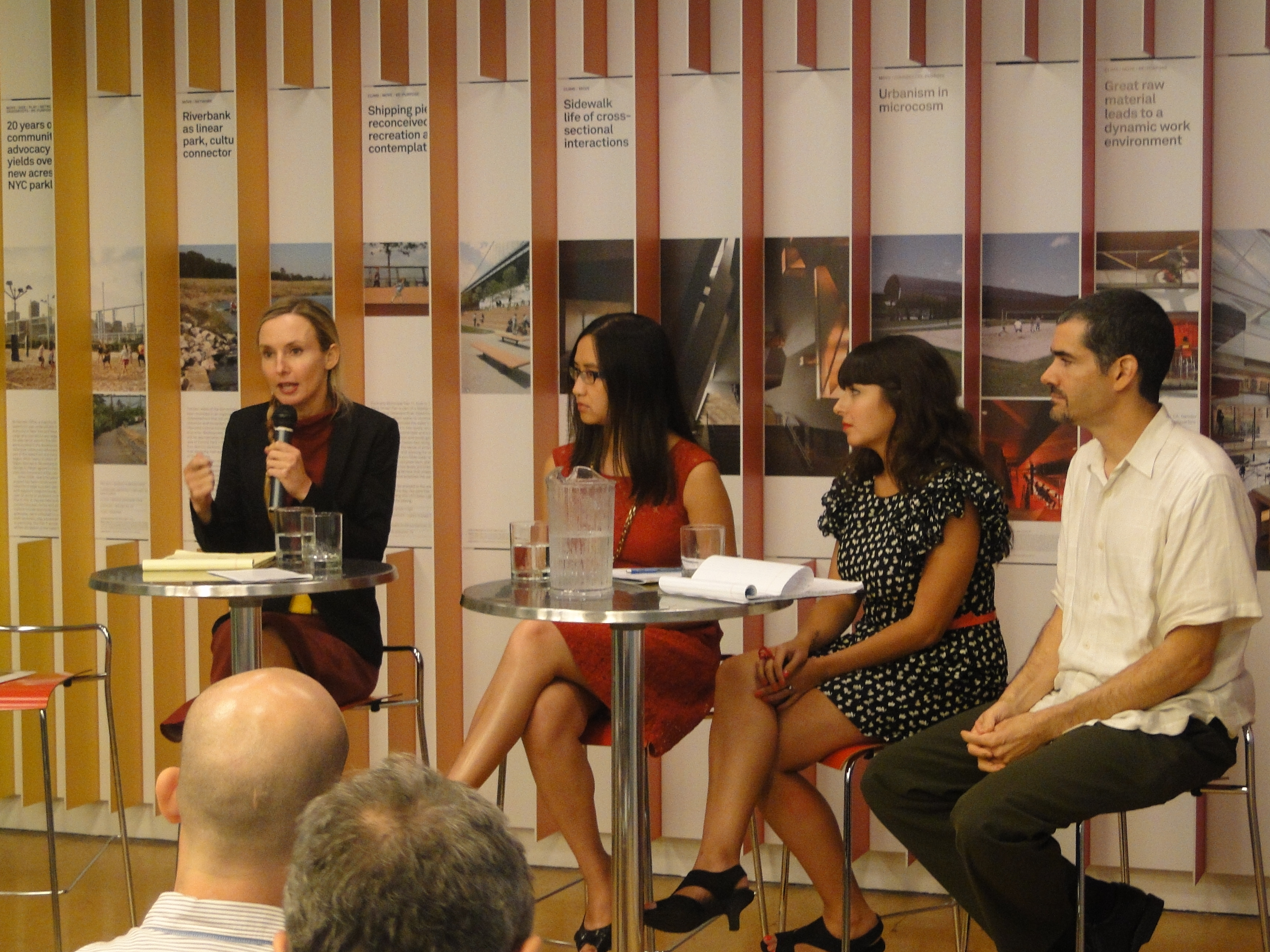by: Bill Millard
When public officials implement Active Design principles in the built environment, they’re not making an arbitrary top-down decision (no matter how often that complaint has arisen from NIMBYs, smokers, the internal-combustion-engine-über-alles faction, and others); they’re responding to expressions of political will. At the most recent FitNation panel, amid an overview of Transportation Alternatives’ (TA) effective campaigns to reclaim street space for human-powered movement and transit, TA spokesperson Jennifer So Godzeno drew a distinction between activists like Jane Jacobs, who create and amplify that political will, and officials like Transportation Commissioner Janette Sadik-Khan, who translate it into policy decisions and constructed forms. Both are indispensable. Citizen activism is an integral aspect of Active Design, the counterweight to all the interests whose inertia supports a pathogenic status quo in built space. The case studies offered here added up to an encouraging pattern of individual initiative driving democratic action to enhance public health.
These efforts have occurred on corporate, civic, and ecosystemic scales. Architect Cristina Crespo, Assoc. AIA, of Gensler’s Washington, DC, office has drawn inspiration from the Active Design Guidelines and spearheaded efforts within her firm and her city to reconfigure spaces, events, and policies accordingly. She frequently blends purpose and whimsy, bringing a Space Invaders motif to a redesigned staircase, replacing mundane office furniture with exercise balls (hey, sedentary employees: work that core while balancing at your computer!), or including hula hoops and a “silent disco zone” among workplace activities. Her work has scaled up from a local Active Design Week and work-floor activity areas to a toolkit promoting physical activity throughout the firm. Strong buy-in on the part of Gensler’s management has been an advantage, and her advocacy is becoming influential citywide through AIADC activities.
Efforts to control auto traffic and institute play streets or bike lanes, So Godzeno pointed out, have arisen from neighborhood grassroots, often in neighborhoods whose interest in better infrastructure (as in Brownsville, Brooklyn, where a seniors’ cycling group worked with the Department of Transportation for two years and succeeded in gaining a superb new lane) only infrequently gets media exposure. On a citywide scale, TA has coordinated survivors’ responses to pedestrian and cyclist deaths at the hands of motorists, both through attention-getting City Hall rallies and through long-range data-collection efforts like www.crashstories.org, compiling the kind of evidence that the police appear reluctant to touch. Grassroots achievements extend beyond the streets to the waterfront and rooftops, added congressional aide Dan Wiley, profiling the Brooklyn Grange commercial green-roof farm (currently thriving in the Navy Yard and Astoria), the Gowanus Dredgers canoeing club, the preservation of the Double-D swimming pool at Douglass and Degraw (threatened by the placement of sewage holding tank during the Superfund cleanup of the Gowanus Canal), the Uprose environmental-justice organization, and others.
Natalie Jeremijenko’s Environmental Health Clinic, which combines public artworks with environmental activism andoperates on the principle that the fullest definition of health is ecological and systemic, not medicalized and anthropocentric, accounting for the well-being of nonhuman organisms as well as human beings. (Among her many rapid-fire witticisms, verbal and otherwise, is the clinic’s eye-catching logo, rotating the Red Cross symbol 45 degrees from a plus sign to a sturdy, defiant red X.) Her clinic serves citizens with environment-related inquiries or complaints – whom she terms “impatients” rather than patients, and she means it as a compliment – by developing creative, often improbable “cures” that recombine biological and technological elements. The approach is not so much back-to-nature as dialectically forward with it, recognizing that human experimentation is sometimes exactly what nature needs to counteract human shortsightedness. Some of her interventions create sanctuary for endangered members of urban ecosystems, such as the Butterfly Bridge (mounting flowering plants on cables above a street in Washington, DC, to attract butterflies away from auto traffic), the Salamander Superhighway, or the Moth Cinema (counteracting a pervasive species bias in built space: “We haven’t designed urban systems as if we knew that moths like light”). Others apply oblique-angled common sense to improve mundane infrastructural components, such as “locating the sport in transport” through zipline-based bakery delivery systems that reduce reliance on trucks; she has even piloted the idea of transporting kids to school by zipline.
Jeremijenko’s energetic respect for the natural world never fades into mere reverence, and her willingness to take on more battles than she can possibly win means that she has her share of collisions with officials. Yet her instinct for the synergies between an ecosystem’s health and that of its constituent organisms leads her to a useful tactical insight: “Absolutely anything goes in environmental design if it improves our health.” Where artistic, political, or theoretical languages can be polarizing, health is a common good, uniting people on either side of development battles. Moderator Sean Robin of the NYC Department of Health and Mental Hygiene invoked Frederick Douglass’s famous motto, paraphrased here as “power concedes nothing without a struggle”; Jeremijenko’s projects and provocations imbue these struggles with exuberance.
Bill Millard is a freelance writer and editor whose work has appeared in Oculus, Icon, The Architect’s Newspaper, and other publications.
Event: FitNation: Active Design and Activism
Location: Center for Architecture, 08.08.2013
Speakers: Cristina Crespo, Assoc. AIA, Co-Chair, AIADC Active Design Committee; Jennifer So Godzeno, MSUP, MPH, Planning Director, Transportation Alternatives; Natalie Jeremijenko, artist, engineer, inventor, and director, xDesign Environmental Health Clinic, NYU; Dan Wiley, Community Coordinator, Office of Congresswoman Nydia M. Velázquez; Sean I. Robin, MCP, Built Environment and Healthy Housing Director, NYC Department of Health and Mental Hygiene (moderator)
Organizers: Center for Architecture
Sponsors: National Endowment for the Arts; AIA, Center for Active Design, Langan, MechoSystems, Sciame, and Skidmore, Owings & Merrill (Patrons); FXFOWLE, Lutron Electronics, Michael Fieldman, Architect, Syska Hennessy Group, and Zetlin & De Chiara (Sponsors); Blue Sea Development Company, Dattner Architects, and ECORE Commercial Flooring (Supporters); Archinect, Bustler (Media Sponsors)









